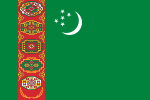Turkmen cuisine
This article needs additional citations for verification. (August 2011) |
| This article is part of a series on the |
| Culture of Turkmenistan |
|---|
 |
| Society |
| Arts and literature |
| Other |
| Symbols |
|
Turkmenistan portal |


Turkmen cuisine, the cuisine of Turkmenistan, is similar to that of the rest of Central Asia. Plov (pilaf) is the staple, everyday food, which is also served at celebrations. It consists of chunks of mutton, carrots and rice fried in a large cast-iron cauldron similar to a Dutch oven. Manti are dumplings filled with ground meat, onions or pumpkin. Shurpa is a meat and vegetable soup. A wide variety of filled pies and fried dumplings are available in restaurants and bazaars, including somsa, (often filled with spinach), and ishlykly. These are popular with travelers and taxi drivers, as they can be eaten quickly on the run, and are often sold at roadside stands. Turkmen cuisine does not generally use spices or seasonings, and is cooked with large amounts of cottonseed oil for flavor.
Chegdermeh, a mixture of rice, meat, tomato and onions, is a uniquely Turkmen dish. Shashlyk, skewered chunks of mutton, lamb, chicken, or sometimes fish, grilled over charcoal and garnished with raw sliced onion and a special vinegar-based sauce, is served in restaurants and often sold in the street. Restaurants in Turkmenistan serve mainly Russian fare such as pelmeni, buckwheat (grechka), golubtsy, and a wide variety of mayonnaise-based salads. Lagman, an Uyghur noodle dish, can also be found in some areas.
Melons[]

In the culinary arena, Turkmenistan is perhaps most famous for its melons, especially in the former Soviet Union, where it was once the major supplier. Though very few melons are exported today,[1] they are a great source of national pride in Turkmenistan and subject of their own Melon Day holiday. Turkmen sources claim the country is home to up to 400 distinct varieties.
Bread[]
Meals are almost always served with naan, Central Asian flat bread, known locally as çörek. Turkmen bread is prepared differently from other breads in the region in thick, round disc-shaped loaves baked in a traditional tamdyr clay oven. Bread has a high symbolic importance in Turkmen culture,[2] and it is considered highly impolite to turn a loaf of bread upside down or to mistreat bread in any way. There are many superstitions based around bread and its preparation. Bread baked with meat inside (etli çörek, or "meat bread") can be consumed as a meal in itself. Ýagly çörek (literally "oily bread") is a flaky, layered type of flat bread made with butter.

Beverages[]
As in the rest of Central Asia, green tea is the primary drink, consumed at all hours. In the Turkmen language, "chai" (tea) can refer to eating a meal or sitting down for a visit. In the Dashoguz region, it is sometimes drunk "Kazakh-style" with milk, often to disguise the salty taste of the drinking water in that area.
Gatyk, a thick drinking yogurt similar to kefir, is often served with breakfast and sometimes used as a condiment on börek or manti, replacing the traditional sour cream. The drink the nation is known for, however, is chal, a fermented camel's milk, which is a white sparkling beverage that has a sour flavour and is popular in Central Asia, particularly in Turkmenistan.[3] Because of specific preparation requirements and it being extremely perishable, chal presents a great challenge for importers to ship outside Turkmenistan or the region for foreign consumption.[4] It is similar to the Kyrgyz drink shoro. One source notes that Turkmens like to get agaran (a type of butter) from the surface of chal.[5]
Alcoholic beverages[]
Vodka is the most popular alcoholic beverage, due to its low cost, followed by beer, wine, brandy, and sparkling wine (Russian: шампанское/shampanskoye).
See also[]
References[]
- ^ Turkmenistan: Country Report to the FAO International Technical Conference on Plant Genetic Resource, Leipzig, 1996, p. 6. Retrieved April 15, 2008
- ^ Sacred Words "Tamdyr" and "Chorek" Paseviev, Ikar. Retrieved April 15, 2008
- ^ Anatoly Khazanov, Nomads and the outside world, Second edition, University of Wisconsin Press, 1994, p. 49
- ^ Great Culinary Dictionary. "Chal" Archived 2007-10-13 at the Wayback Machine in Russian, retrieved April 11, 2007
- ^ I.Barkhanov. Neutral Turkmenistan newspaper Archived 2005-11-10 at the Wayback Machine, in Russian, August 9, 2001.
External links[]
- One Turkmen Kitchen
- Vopr Pitan. "Chemical composition of chal (fermented camel's milk)", 1954 Jul-Aug;13(4):41-2
- Martinenko, N.l., Yagodinskaya, S.G., Adhundov, A.A., Charyev, K.C. and Khumedov, O. (1977). Content of trace elements, copper, manganese, molybdenum in culture of chal and camel's milk and their clinical significance. Dairy Sci. Abst., 40(7802), p. 824
- B. Faye and P. Esenov (eds.). Desertification Combat and Food Safety. The Added Value of Camel Producers. Volume 362 NATO Science Series: Life and Behavioural Sciences. OS Press Publication, February 2005, 240 pp., hardcover ISBN 1-58603-473-1
- Filip Noubel, "GOLDEN CENTURY OF THE TURKMENS:" A BLEAK PICTURE OF VILLAGE LIFE IN THE DESERT. EurasiaNet photo essay, 2002-10-25
- Turkmenistan cuisine
- Central Asian cuisine
